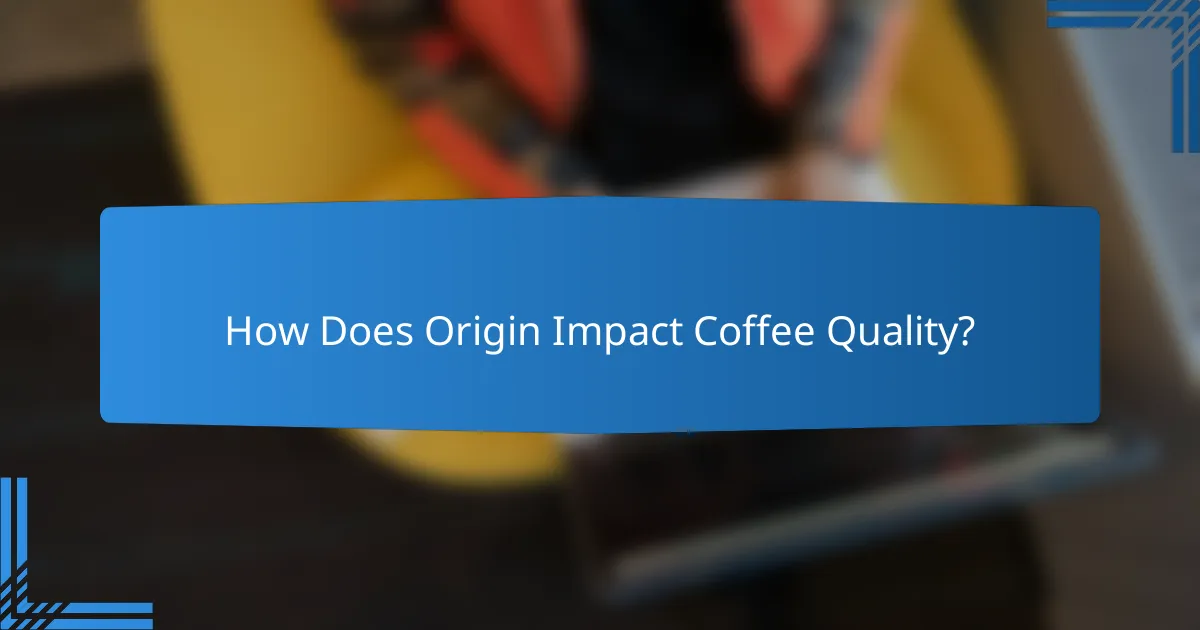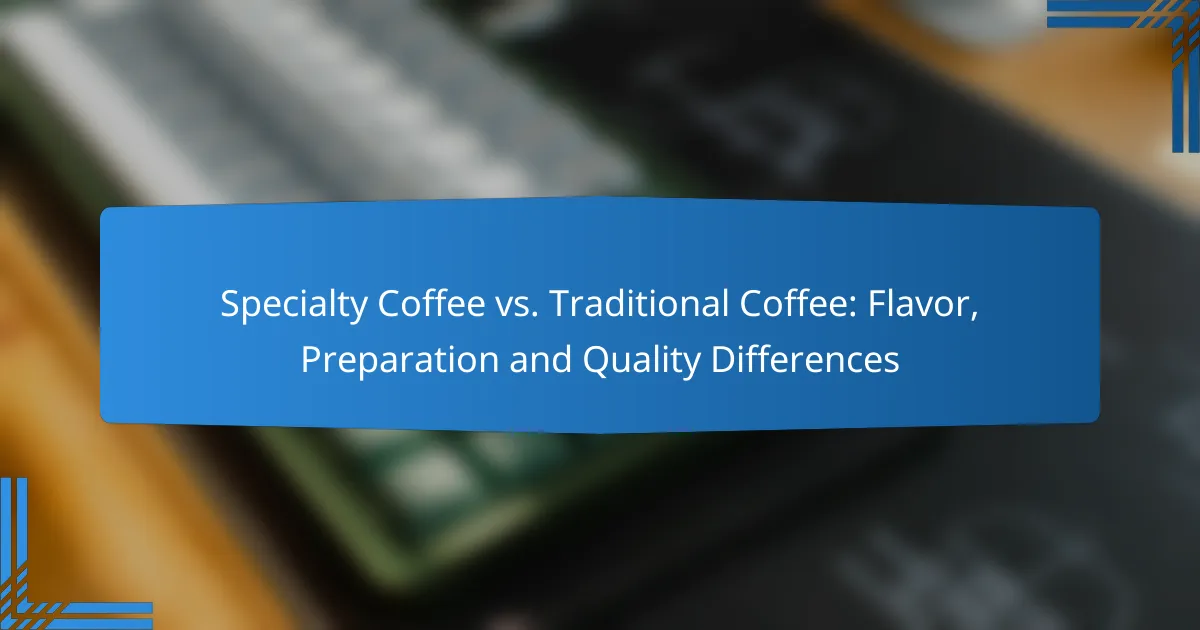Specialty coffee stands out for its unique flavor profiles and high quality, often requiring a score above 80 points on a standardized scale. In contrast, traditional coffee offers a more consistent taste, influenced by simpler preparation methods that prioritize convenience over precision. The differences in flavor, preparation techniques, and bean quality highlight the distinct experiences each type of coffee provides.

What Are the Flavor Differences Between Specialty Coffee and Traditional Coffee?
Specialty coffee is characterized by its unique and diverse flavor profiles, while traditional coffee tends to have a more consistent and uniform taste. The differences arise from factors such as bean quality, preparation methods, and the specific varietals used.
Specialty coffee has distinct flavor profiles
Specialty coffee is often sourced from specific regions and farms, leading to a wide range of flavor notes that can include fruity, floral, or nutty characteristics. These coffees are typically graded based on strict quality standards, often scoring above 80 points on a 100-point scale established by the Specialty Coffee Association.
For example, a single-origin Ethiopian coffee may present bright acidity with berry notes, while a Guatemalan coffee might showcase chocolate and caramel flavors. This diversity allows coffee enthusiasts to explore and appreciate various tasting experiences.
Traditional coffee offers a more uniform taste
In contrast, traditional coffee often consists of blends that prioritize consistency over unique flavors. These blends are designed to create a balanced taste that appeals to a broad audience, resulting in a more predictable flavor profile.
Commonly found in commercial brands, traditional coffee may lack the complexity of specialty options, often tasting more bitter or flat. This uniformity can be appealing for those who prefer a reliable cup of coffee without the nuances found in specialty varieties.
Varietals influence flavor complexity
The varietals of coffee beans play a crucial role in determining flavor complexity. Specialty coffees often feature heirloom or unique varietals that contribute to their distinct taste, while traditional coffees typically use more common varietals that yield a simpler flavor profile.
For instance, Arabica beans, often used in specialty coffee, can exhibit a wide range of flavors depending on their growing conditions, whereas Robusta beans, frequently found in traditional blends, tend to have a stronger, more bitter taste. Understanding these varietals can enhance your appreciation of different coffees.
Brewing methods affect flavor extraction
The brewing method significantly impacts the flavor extraction of both specialty and traditional coffee. Specialty coffee is often brewed using methods like pour-over or French press, which allow for greater control over extraction time and temperature, enhancing the coffee’s unique flavors.
On the other hand, traditional coffee is frequently made using drip coffee makers or espresso machines, which may not highlight the subtleties of the beans. Experimenting with different brewing techniques can help you discover the best way to enjoy each type of coffee.

How Do Preparation Methods Differ?
Preparation methods for specialty coffee and traditional coffee differ significantly in terms of precision, techniques, and equipment used. Specialty coffee focuses on meticulous brewing processes to enhance flavor, while traditional coffee often employs more straightforward methods that prioritize convenience.
Specialty coffee emphasizes precision in brewing
Specialty coffee preparation involves precise measurements of coffee grounds, water temperature, and brewing time. Techniques such as pour-over, siphon, and cold brew are common, requiring attention to detail to extract optimal flavors. Baristas often use scales and thermometers to ensure consistency and quality in each cup.
For instance, a pour-over method may require a water temperature between 90-96°C and a brew time of 2-4 minutes. This level of control allows for the highlighting of unique flavor notes inherent to the coffee beans.
Traditional coffee often uses simpler methods
Traditional coffee preparation typically involves straightforward techniques like drip brewing or using a French press. These methods are generally less time-consuming and do not require specialized equipment or precise measurements. As a result, they are more accessible for everyday consumers.
For example, a standard drip coffee maker simply requires adding water and coffee grounds, making it a quick option for brewing multiple cups at once. This simplicity often sacrifices some flavor complexity compared to specialty methods.
Equipment varies between specialty and traditional
The equipment used for specialty coffee often includes high-quality grinders, pour-over drippers, and espresso machines, which can be more expensive and require maintenance. Specialty coffee tools are designed to enhance the brewing process and improve flavor extraction.
In contrast, traditional coffee equipment is usually more basic, such as standard drip coffee makers or percolators, which are widely available and affordable. This difference in equipment reflects the varying priorities of flavor versus convenience in coffee preparation.

What Are the Quality Standards for Specialty Coffee?
Specialty coffee is defined by its high quality, requiring a score above 80 points on a 100-point scale established by the Specialty Coffee Association (SCA). This scoring system evaluates various attributes, including flavor, aroma, acidity, and body, ensuring that only the best coffees meet specialty standards.
Specialty coffee must score above 80 points
To be classified as specialty coffee, a coffee must achieve a score of at least 80 points during evaluation. This scoring is based on a comprehensive assessment of its sensory qualities, where coffees scoring between 80-84 are considered good, while those scoring above 85 are regarded as excellent. This rigorous scoring system helps consumers identify top-tier products.
Quality is assessed through cupping
Cupping is the standard method used to evaluate coffee quality in the specialty sector. During this process, trained tasters assess the coffee’s aroma, flavor, acidity, body, and aftertaste. Each attribute is scored, and the cumulative score determines if the coffee meets the specialty criteria.
Traceability is key in specialty coffee
Traceability refers to the ability to track the coffee’s journey from farm to cup. In specialty coffee, this is crucial as it ensures transparency and accountability in sourcing practices. Consumers often prefer coffees that can be traced back to specific farms or regions, as this information can enhance the perceived quality and ethical standards of the product.

How Does Origin Impact Coffee Quality?
The origin of coffee significantly affects its quality, flavor profile, and overall characteristics. Factors such as geographic location, altitude, and local processing methods play crucial roles in determining the final taste and quality of the coffee beans.
Geographic factors influence flavor
Geographic factors, including climate and soil composition, directly impact the flavor of coffee. For instance, beans grown in Colombia often have a smooth, mild flavor due to the country’s unique climate and rich volcanic soil. In contrast, Ethiopian coffee tends to have fruity and floral notes, attributed to its diverse growing conditions.
Regions known for coffee cultivation, such as Central America, Africa, and Asia, each produce beans with distinct flavor profiles. Understanding these geographic influences can help consumers choose coffee that aligns with their taste preferences.
Altitude affects bean quality
Altitude plays a vital role in the quality of coffee beans. Generally, higher elevations produce beans with more complex flavors and greater acidity. For example, coffee grown at altitudes above 1,200 meters often exhibits brighter and more nuanced flavors compared to beans from lower elevations.
Farmers in regions like the Andes or the Ethiopian Highlands benefit from this relationship, as the cooler temperatures slow the maturation of the coffee cherries, enhancing their flavor development. When selecting coffee, consider the altitude of the origin for a better tasting experience.
Processing methods vary by region
The method used to process coffee beans after harvesting can vary significantly by region and impacts the final flavor. Common processing methods include washed, natural, and honey processing, each imparting different characteristics to the coffee.
For instance, washed coffees, often found in Colombia, tend to have a cleaner taste, while natural processed coffees, prevalent in Ethiopia, can exhibit fruity and wine-like flavors. Understanding these processing methods can help consumers appreciate the diversity in coffee quality and flavor based on origin.

What Are the Health Benefits of Specialty Coffee?
Specialty coffee offers several health benefits, primarily due to its higher quality and unique preparation methods. It typically contains more antioxidants and beneficial compounds compared to traditional coffee, which can contribute to overall health and well-being.
Higher antioxidant levels in specialty coffee
Specialty coffee is known for its elevated antioxidant levels, which help combat oxidative stress in the body. Antioxidants, such as chlorogenic acids, are more prevalent in high-quality beans, often sourced from specific regions and processed with care.
These antioxidants can support heart health, reduce inflammation, and may lower the risk of chronic diseases. For instance, studies suggest that consuming specialty coffee could lead to a modest decrease in the risk of conditions like diabetes and cardiovascular disease.
When choosing specialty coffee, look for beans labeled as “single-origin” or “organic,” as these often have higher antioxidant content. Additionally, brewing methods like pour-over or French press can preserve these beneficial compounds better than standard drip coffee.
